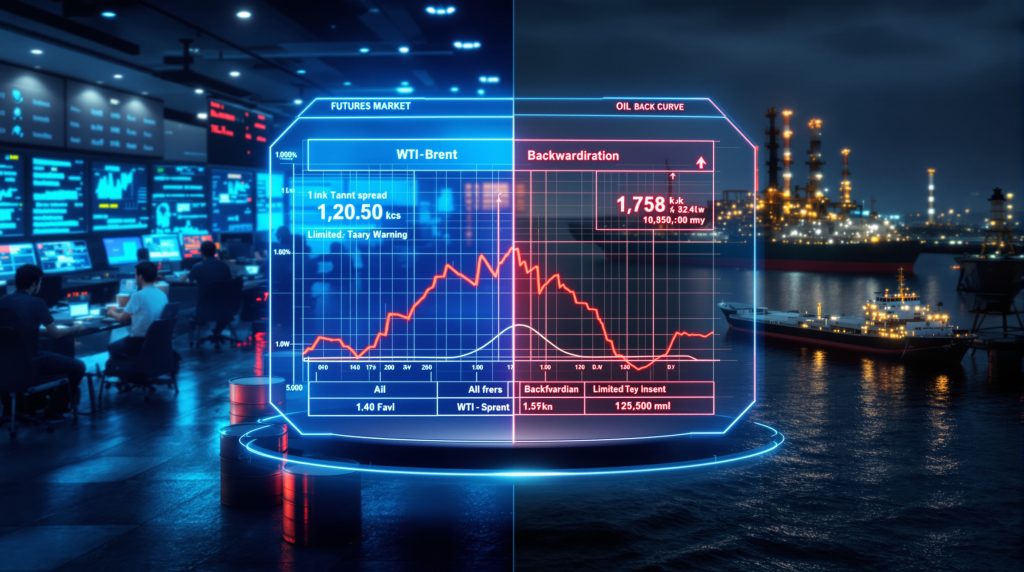Understanding the Disconnect Between Futures and Physical Oil Markets
The global oil market is experiencing a peculiar phenomenon where paper market signals contradict physical market realities. This divergence reveals fundamental tensions between financial expectations and real-world supply-demand dynamics that significantly impact oil price movements and trading strategies.
The Current Market Paradox
Recent market data reveals Brent futures maintaining a backwardated structure (where future prices are lower than current prices), while physical North Sea crude grades struggle to maintain their premiums. This contradiction signals a market divided between what traders expect to happen and what physical buyers are actually willing to pay for immediate delivery.
The disconnect is particularly noticeable in key benchmarks like Forties crude, which has struggled to clear at premiums to Dated Brent despite strong paper signals. Meanwhile, WTI crude from the United States continues arriving in European markets at economically attractive rates despite theoretical barriers that should make such trades unprofitable.
| Market Indicator | Paper Market Signal | Physical Market Reality |
|---|---|---|
| Brent Futures | Backwardated structure indicating tightness | North Sea physical grades trading at weak premiums |
| Gasoil Cracks | Strong on paper, suggesting product shortages | Physical barrels flowing at discounts |
| WTI-Brent Spread | Relatively tight | US crude arriving in Europe at attractive economics |
| Risk Premium | Elevated in futures contracts | Not reflected in spot transactions |
How Futures Markets Differ From Physical Markets
The Nature of Paper Trading
Futures contracts represent financial instruments that allow traders to speculate on future oil prices without necessarily taking physical delivery. These "paper barrels" trade at volumes that vastly exceed actual oil consumption—often exceeding 28 times the daily global consumption for major benchmarks like Brent and WTI.
Paper markets are highly liquid and dominated by financial participants including hedge funds, institutional investors, and algorithmic traders who may have limited interest in the underlying physical commodity. Their primary focus lies in price movements rather than the logistical realities of moving actual oil barrels.
Physical Market Realities
The physical market involves actual barrels changing hands between producers, refiners, and consumers. Here, prices reflect immediate supply-demand balances, logistical constraints, quality differentials, and regional factors that paper markets often overlook or undervalue.
Physical traders must contend with shipping costs, storage limitations, refinery configurations, and quality specifications that create complex pricing dynamics beyond the standardized futures contracts.
Price Formation Differences
- Futures prices incorporate expectations about future events, geopolitical risks, and financial flows
- Futures markets tend to react strongly to headlines and potential disruptions
- Physical prices reflect immediate availability, quality premiums/discounts, and regional demand
- Physical markets respond to actual flows and operational constraints rather than anticipated events
Why Oil Futures Show Strength While Physical Markets Weaken
Refining Capacity as the True Bottleneck
The global oil system faces constraints not in crude supply but in refining capacity. Recent data indicates:
- Global conversion units are operating near their practical limits
- Reliability issues persist at major refineries (as seen with Dangote's RFCC unit troubles)
- Winter is approaching with diesel stocks below seasonal norms
- The system has limited flexibility to absorb additional disruptions
While crude oil production remains robust globally, the ability to process that crude into usable products has become the critical constraint. This creates a situation where crude oil itself can be oversupplied while certain refined products remain tight.
Geopolitical Risk Premium in Futures
Futures markets are pricing in potential supply disruptions that haven't fully materialized:
- Ongoing strikes on Russian refining infrastructure have reduced operational capacity
- Middle East tensions continue affecting shipping routes and insurance rates
- Uncertainty around OPEC meeting impact creates forward price volatility
- Potential sanctions impacts on global flows remain a significant concern for traders
The paper market builds a risk premium into prices to account for these possibilities, even when actual disruptions are limited or temporary.
Physical Market Oversupply Signals
Meanwhile, physical markets show clear signs of oversupply:
- Forties crude (North Sea benchmark) struggles to clear at premiums to Dated Brent
- WTI arriving in Northwest Europe at competitive prices despite theoretical arbitrage barriers
- Global crude exports reaching multi-year highs according to shipping data
- Increasing volumes of oil stored on floating storage indicating clearing issues
These physical indicators suggest that immediate supply exceeds demand, contradicting the tightness signaled by futures markets.
How Regional Factors Affect the Disconnect
North Sea Market Dynamics
The North Sea represents a crucial pricing hub where the disconnect is particularly visible:
- FOB premiums for light sweet grades showing persistent weakness
- Dated Brent assessments not reflecting the strength seen in futures contracts
- Regional refiners accessing alternative supplies at competitive rates
- Quality adjustments and freight considerations creating complex differentials
This regional market serves as a critical indicator of physical market conditions that often contradicts the narrative in financial markets.
Impact of US Crude Exports
The surge in US crude exports has transformed global oil flows:
- WTI arriving in Europe at attractive economics despite futures spreads suggesting otherwise
- US exports reaching record levels, pressuring physical differentials globally
- Arbitrage opportunities shifting regional price relationships as US barrels displace traditional suppliers
- US oil production decline creating additional complexities for refiners evaluating import economics
American crude exports have become a key balancing mechanism in global markets, often responding more quickly to physical price signals than producers in other regions.
Asian Market Influences
Refining activity in Asia affects global balances:
- Strong summer runs in key Asian markets (India, China) absorbing significant volumes
- Saudi crude processing increasing year-on-year, with resulting products flowing to export markets
- Brazilian throughput reaching decade-high levels, affecting regional supply-demand balances
- Chinese independent refiners' buying patterns creating ripple effects throughout global markets
Asian refining decisions have outsized impacts on global flows, creating complex interconnections between regional markets that futures prices can't fully capture.
What Role Does Market Structure Play?
Backwardation vs. Contango
The futures curve shape provides important signals:
- Backwardation (current prices higher than future prices) typically indicates market tightness
- Contango (future prices higher than current prices) suggests oversupply
- Current backwardated structure contradicts physical market weakness
- The degree of backwardation offers clues about market sentiment and storage economics
The persistence of backwardation despite physical weakness represents one of the key disconnects in today's oil markets.
Dated Brent vs. Futures Mechanism
The relationship between dated assessments and futures contracts can amplify disconnects:
- Dated Brent represents physical cargoes loading in the next few weeks
- Futures reflect expectations for delivery months ahead
- The assessment methodology can create temporary divergences during rapid market shifts
- The complex web of forward contracts, physical assessments, and derivatives creates friction
This intricate plumbing between physical and paper markets can magnify stress during periods of uncertainty.
The Role of Freight Rates
Shipping costs significantly impact arbitrage economics:
- VLCC strength affects global crude flows by changing the economics of long-haul movements
- Shifting arbitrage opportunities distort regional clearing prices
- Freight rate volatility amplifies paper market moves by changing physical delivery economics
- Regional shipping constraints create bottlenecks that paper markets cannot easily account for
Maritime transportation costs function as a critical variable that can either facilitate or block the physical movements needed to balance regional markets.
How Seasonal Factors Influence This Disconnect
Refinery Maintenance Patterns
Seasonal maintenance affects physical demand:
- Global turnaround season reduces immediate crude demand as units go offline
- Capacity returns gradually rather than all at once, creating uneven demand recovery
- Maintenance schedules creating temporary regional imbalances
- Unexpected extension of planned work can exacerbate regional tightness
These cyclical patterns create predictable periods of disconnect between the disconnect between paper and physical oil markets.
Winter Product Demand Expectations
Anticipated seasonal shifts influence futures:
- Winter approaching with diesel stocks below seasonal averages in many regions
- Heating oil demand expected to increase in Northern Hemisphere
- Gasoil cracks strengthening in anticipation of winter needs
- Futures market pricing in potential weather-related demand spikes before they materialize
The anticipatory nature of futures trading means winter concerns are priced in before physical demand materializes.
Inventory Cycles
Seasonal stock building and drawing patterns affect market balance:
- Q4 typically sees inventory builds ahead of winter in many regions
- Current global crude exports at multi-year highs contributing to inventory accumulation
- Oil accumulating in floating storage indicating oversupply in immediate timeframes
- Inventory management strategies vary regionally, creating uneven demand patterns
These cyclical patterns create predictable periods of disconnect that experienced traders can anticipate.
What Market Metrics Should Traders Monitor?
Key Indicators to Watch
Several metrics help track the paper-physical disconnect:
- WTI-Brent spread movements indicate changing arbitrage economics
- North Sea FOB premiums relative to Dated Brent reflect physical market strength
- Gasoil and naphtha crack spreads reveal product market dynamics
- East-West differentials for key products highlight regional imbalances
Monitoring these relationships provides early warning signals about evolving market conditions.
Refining Margins as Leading Indicators
Refining economics provide crucial insights:
- Strong margins despite high throughput suggest persistent capacity constraints
- Product crack spreads elevated despite weak physical crude point to refining bottlenecks
- Regional variations in margins highlighting arbitrage opportunities
- Shifting margins across different refinery configurations reveal quality preferences
Refining economics often lead other market indicators, making them valuable predictive tools.
Inventory and Export Data
Physical flows reveal fundamental balances:
- Rising global crude exports signaling oversupply conditions
- Increasing floating storage indicating clearing issues for physical barrels
- Regional stock levels relative to seasonal norms showing localized imbalances
- Strategic reserve movements affecting market sentiment
These physical metrics provide reality checks against paper market expectations.
When and How Will Paper and Physical Markets Realign?
Potential Reconciliation Pathways
The current disconnect must eventually resolve through:
- Physical premiums rebuilding as feared supply disruptions materialize into actual constraints
- Paper structure cooling if anticipated shortages fail to develop as expected
- A combination of both as markets find equilibrium through price discovery
Markets cannot maintain divergent signals indefinitely, as arbitrage opportunities eventually force convergence.
Timing Considerations
Several factors will determine reconciliation timing:
- Durability of Russian product exports after refinery strikes
- Pace and stability of refinery restarts after maintenance season
- Evolution of WTI-Brent spread and North Sea FOB premiums
- Seasonal demand patterns as winter approaches in the Northern Hemisphere
The convergence timeframe depends on how quickly these fundamental factors evolve.
Risk Management Implications
The disconnect creates both challenges and opportunities:
- Positioning requires disciplined risk limits given the potential for rapid realignment
- Spread trading strategies may capture convergence as markets rationalize
- Physical market participants face basis risk during divergence periods
- Options strategies can provide protection against violent reconciliation moves
Sophisticated market participants develop strategies to benefit from the eventual convergence.
What Are the Implications for Energy Market Participants?
For Crude Producers
The disconnect affects production and hedging decisions:
- Paper prices may not reflect realized sales values, creating basis risk
- Regional differentials become more important than benchmark prices for revenue forecasting
- Hedging strategies require adjustment to account for basis risk
- Production scheduling decisions need to consider physical clearing conditions
Producers must navigate between favorable paper signals and challenging physical realities.
For Refiners
Refiners face complex margin calculations:
- Strong product cracks despite weak physical crude create attractive theoretical margins
- Opportunity to capture wider margins during disconnect periods by securing discounted feedstock
- Need to optimize crude slates based on physical differentials rather than benchmark prices
- Flexibility to adjust product yields becomes increasingly valuable
Refiners with sophisticated trading operations can capitalize on these market inefficiencies.
For Traders and Investors
The split market creates trading opportunities:
- Arbitrage between paper and physical markets for those with logistical capabilities
- Spread trading between regional benchmarks to capture convergence
- Calendar spreads reflecting expectations versus reality
- Strategic inventory management to benefit from temporal disconnects
Sophisticated traders view market disconnects as profit opportunities rather than anomalies.
Navigating the Divided Oil Market
The disconnect between paper and physical oil markets represents a temporary but significant divergence in market signals. While futures prices incorporate risk premiums and expectations of future tightness, physical markets reflect current oversupply and refining constraints.
This split-screen reality requires market participants to monitor both sides of the equation. The key factors that will determine market direction include:
- The resilience of Russian product exports despite refinery attacks
- Global refinery operations through maintenance season
- The behavior of key spreads like WTI-Brent and physical premiums
Until these factors provide clearer direction, oil markets will continue operating on parallel tracks—oil price stagnation on paper but soft in reality. This divergence creates both risks and opportunities for different market participants, highlighting the importance of understanding both the financial and physical dimensions of global oil markets.
Disclaimer: Oil market conditions are subject to rapid change due to geopolitical events, weather patterns, policy decisions, and technological developments. The information in this article represents a snapshot of current market dynamics and should not be considered investment advice. Always consult with qualified financial advisors before making significant trading or investment decisions.
In times of significant oil & gas downturn, the disconnect between paper and physical markets often becomes even more pronounced, creating both challenges and opportunities for market participants who understand these complex dynamics.
Want to Identify the Next Major Mineral Discovery Before the Market?
Discovery Alert's proprietary Discovery IQ model instantly notifies investors of significant ASX mineral discoveries, turning complex geological data into actionable investment insights. Explore how historic discoveries have generated substantial returns by visiting our dedicated discoveries page and begin your 30-day free trial today.




